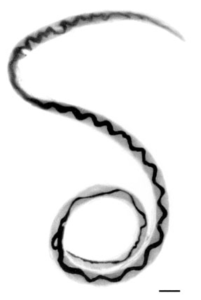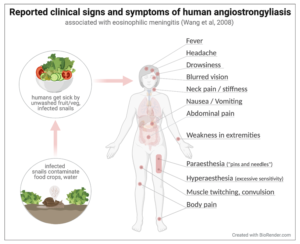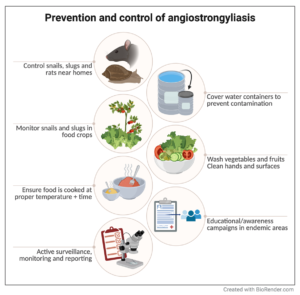
Under the microscope, female Angiostrongylus cantonensis have a distinctive feature that makes them instantly recognisable and fascinating to look at: white uterine tubes and red blood-filled intestines intertwine along the length of the nematode’s body, resulting in a barber pole or candy cane appearance. The male worms, on the other hand, are identifiable by a terminal copulatory bursa that looks like a delicate mantle surrounding a few short tentacles. Together, they constitute a happy couple of rat lungworms.

Rats, as definitive hosts, harbour these nematodes in their lungs; the worms are coughed up, swallowed, and finally passed out in the rat’s faeces. Slugs or snails (intermediate hosts) are infected by ingesting the rat’s waste. These gastropods, in turn, are part of the rat’s regular menu, so the cycle is maintained.
But like many parasites, the rat lungworm often finds its way to other animals, including freshwater shrimp, crabs and frogs – accidental hosts. Humans are infected by consuming undercooked dishes with any of these hosts, which can be part of many cuisines worldwide, or by unwashed contaminated produce (like raw salads). Initial disease symptoms can be non-specific, like abdominal pain, nausea, and vomiting. In some cases, the parasites may reach the brain and cause eosinophilic meningitis. When the central nervous system is compromised, symptoms worsen to chronic debilitating migraines, impaired vision and hearing, and flaring skin sensitivity and pain, among others. Diagnosis can be difficult, and patients showing the first clinical signs of rat lungworm infections have been misdiagnosed as having a flu or a non-threatening illness. Around 2800 cases had been reported up to 2008; although there are no published updates of cases to date, they are likely to have increased significantly with the frequency of travel across the world.
Angiostrongyliasis suffering goes beyond that of the disease itself – as patients are incapacitated and unable to work, families are also affected when they need to become fulltime caregivers, and income losses follow. Animals infections can lead to euthanasia of pets and livestock. Recognition of rat lungworm disease by medical professionals is key to begin timely treatment and reduce the severity of sequelae.

How did the rat lungworm get to Mallorca?
In the beautiful isle of Mallorca, millions of tourists have basked in the sun, lazy seas lapping at their feet, as they gaze at the blue-green hues stretching between them and the horizon. It is in this popular destination that Dr. Claudia Paredes-Esquivel and her team conduct their work as part of an animal conservation research group at the University of the Balearic Islands. Her team studies the pathogens of both native fauna and invasive species, often in collaboration with the island’s Consortium for Wildlife Recovery (COFIB).
In October 2018, the COFIB admitted two North African hedgehogs with signs of severe central nervous system damage. As the hedgehogs had lost the ability to control their limbs and mouth, both were euthanised to prevent further suffering. After some detective work involving delicate necropsies, Paredes-Esquivel’s team discovered little barber pole nematodes in the brains of both hedgehogs. Further molecular analyses confirmed their initial suspicions: both animals had been infected with A. cantonensis. “Other infected hedgehogs have since been found, and the evidence suggests there is active disease transmission happening in Mallorca” Dr. Paredes-Esquivel says, “I believe this is part of a larger problem that needs to be urgently addressed”.
Although the neurological symptoms had been previously noticed in the island’s hedgehogs, an Angiostrongylus infection was never suspected because: 1) angiostrongyliasis has never been reported on the island and 2) hedgehogs have never been identified as a host species before. One of the group’s most important discoveries was the presence of sexually mature worms in the hedgehog brains. If A. cantonensis only reproduce in the definitive host, does it mean hedgehogs are now part of this parasite’s life cycle? This is a key question Dr. Paredes-Esquivel and her colleagues are trying to answer. They are also investigating how this parasite arrived on the island, what role the hedgehogs and other animals play in the worm’s lifecycle, and more importantly, what are the disease risks to island inhabitants and visitors.
For a relatively unknown parasite, the rat lungworm has a surprisingly wide distribution that includes dozens of cities in nearly all continents. And now, Mallorca. It is well known that the constant sea and air traffic into Mallorca, fuelled mainly by millions of tourists every year, has increased invasive species in the island. COFIB launched a ‘green line’ app that in six months has received reports of over 500 invasive species in the Balearics. This has likely included infected rats and snail hosts to the island, and Mallorcan hedgehogs feeding on infected snails are susceptible to this invasive parasite.

Prevention measures for those living in endemic areas include the proper handling of food and contaminated surfaces, and the education of both health personnel and the general public on disease risks. While this story may lead some people to conclude that all hedgehogs are now dangerous, this is certainly not the case. On the contrary, they are extremely valuable for disease surveillance, especially in fragile island ecosystems like Mallorca. Here, the active monitoring for A. cantonensis infections will be a critical step towards controlling the spread of this invasive parasite within the island and will serve as an example for other places as this parasite continues to spread.

Comments